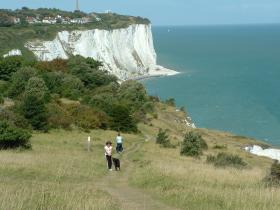Good news for wildlife on the White Cliffs of Dover
| Good news for wildlife on the White Cliffs of Dover The National Trust is celebrating the success of its £1.2 million White Cliffs of Dover appeal to raise funds to acquire the 0.8 mile stretch of the White Cliffs of Dover coastline. This is a considerable achievement, raising the required funds in just 133 days – that’s an average of £9,000 a day! The National Trust acquired its first stretch of the White Cliffs of Dover in 1968 and hundreds of thousands of people visit them every year to enjoy the views across the English Channel. The success completes the missing link of coastline under the Trust’s care, linking its visitor centre and South Foreland Lighthouse. The 8 kilometres of coastline are home to rare species of wildlife. Overall, the National Trust manages 700 miles of coastline around the UK.
The White Cliffs of Dover... home to wildlife Wildlife will benefit from the National Trust's successful appeal, thanks to donors. Most of the land acquired has been used for growing crops, but it will now be taken otu of agricultural use and restored to chalk grassland. This is a rare & important habitat for wildlife. It means the Trust can manage a larger natural area, in which plants & wildlife can benefit. The cliffs are home to wildlife such as the Adonis blue butterfly, chalkhill blues, the red admiral, painted lady and yellow clouded butterfly. The latter are more in evidence during their migration when they fly to the UK from Africa. In July you may see rare moths such as the day-flying straw belle. The wasp spider, erminemoth caterpillar and endangered hornet-robberfly. The White Cliffs of Dover are also home to rare coastal plants and birds such as the skylark, the only pair of breeding ravens in Kent, and peregrine falcons. There are kittiwakes, futmar in summer, yellow hammers, kennet and the whitethroat. Ravens first nested on the site in 2010
|
